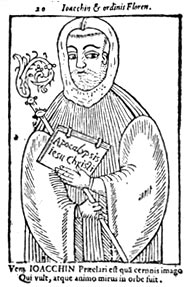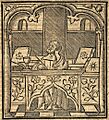Joachim of Fiore facts for kids
Quick facts for kids
Joachim of Fiore
|
|
|---|---|

Joachim of Flora, in a 15th-century woodcut
|
|
| Born | 1135 Celico, Calabria, Kingdom of Sicily
|
| Died | 1202 |
| Era | Medieval philosophy |
| Region | Western philosophy |
| School | Joachimitism Historicism |
|
Notable ideas
|
Premillennialism Three Eras |
|
Influenced
|
|
Joachim of Fiore, also known as Joachim of Flora (Italian: Gioacchino da Fiore; Latin: Ioachim Florensis; around 1135 – March 30, 1202), was an Italian Christian thinker and a Catholic abbot. He started a special group of monks called the monastic order of San Giovanni in Fiore.
Many people consider Joachim of Fiore a very important thinker from the Middle Ages. His ideas about the future and how history unfolds were quite famous. Some believe his thoughts even inspired parts of Dante Alighieri's famous book, Divine Comedy. People who followed his ideas later were known as Joachimites.
Contents
Joachim's Life Story
Joachim was born in a small village called Celico in Calabria, which was part of the Kingdom of Sicily at the time. His father, Mauro de Celico, was a well-known notary (someone who prepares legal documents). Joachim was educated in Cosenza and first worked in courts, then became a notary himself.
Around 1159, he went on a long journey to the Holy Land. In Jerusalem, he had a deep spiritual experience that changed his life. He decided to leave his worldly life behind. When he came back, he lived alone as a hermit for several years, traveling and sharing his ideas.
Later, he joined the Cistercian monastery of Sambucina in Calabria. He spent his time preaching. The church leaders had some concerns about his way of life, so Joachim joined the monks at the Abbey of Corazzo. He became a priest around 1168.
He spent all his time studying the Bible, especially the Book of Revelation. He believed there were hidden meanings in the Scriptures. The monks at Corazzo chose him to be their abbot around 1177. He tried to connect his monastery to the Cistercian Order, but they refused because the community was poor. In 1178, he asked King William II of Sicily for help, and the king gave the monks some land.
In 1182, Joachim asked Pope Lucius III for permission to focus only on his writings, and the Pope agreed. Joachim spent the next year and a half at the Cistercian Abbey of Casamari. There, he wrote his three main books. His secretary, Lucas, was amazed to see such a famous and wise man wearing simple clothes and showing great devotion when he preached.
In 1184, he was in Rome and continued to be supported by different popes. Joachim later moved to a quiet place called Pietralata to continue writing. Then, he started his own monastery, the Abbey of Fiore (Flora), in the mountains of Calabria.
In 1196, on Good Friday, Empress Constance asked Joachim to hear her confession in the Palatine Chapel. She first sat on a high chair, but Joachim told her that she should sit on the ground, and she did.
The Abbey of Fiore became the center of a new, stricter group within the Cistercian order. Celestine III approved this new group in 1198.
In 1200, Joachim showed all his writings to Innocent III for review. He died in 1202 before any decision was made about his works. People widely respected his holy life. Even Dante wrote that miracles were said to happen at Joachim's tomb. Although he was never officially made a saint, he is still honored as a blessed person on May 29.
Joachim believed a new age would begin, where the Church might not be needed in the same way. He thought people of all faiths would come together. Members of the Franciscan order saw him as a prophet, but Joachim himself said he was not one. He was very popular during his time. Richard the Lionheart even met him in Messina before going on the Third Crusade to ask for his advice.
Joachim's famous diagram of three circles, which looked like the letters "IEUE" (a name for God), influenced how the Borromean rings were used as a symbol for the Christian Trinity.
Joachim's Idea of Three Ages
Joachim had a special idea about history, which he called the "eternal gospel." He based this on a verse from the Book of Revelation (Revelation 14:6).
He believed that history could be divided into three main periods, similar to the Trinity:
- The Age of the Father: This period was like the Old Testament. People followed God's rules.
- The Age of the Son: This period started with Jesus Christ and lasted until about 1260. It was like the New Testament, where humans became closer to God.
- The Age of the Holy Spirit: Joachim believed this age was coming soon. He imagined it as a time of deep thought and peace. In this new age, people would understand God's words in a much deeper way, not just literally. He thought a new group of spiritual people would rise, making the current Church structure less important. This idea later influenced the Cult of the Holy Spirit in Portugal.
Why Some of His Ideas Were Disputed
Some of Joachim's ideas were discussed and debated by other thinkers. For example, Thomas Aquinas, another famous theologian, disagreed with some of his theories. However, Dante Alighieri placed Joachim in the highest heaven in his Divine Comedy, showing his respect.
After Joachim's death, some writings that were not truly his began to spread under his name. In 1215, a big church meeting called the Fourth Council of the Lateran criticized some of his ideas about the Holy Trinity. Later, in 1263, a group of church leaders at the Synod of Arles declared some of Joachim's theories, and those of his follower Gerardo of Borgo San Donnino, as heretical (meaning against official church teachings). The main problem was his different view of the Holy Trinity.
His ideas also inspired several other groups, like the Amalricians and the Dulcinians. These groups were also later declared heretical by the Catholic Church. However, it's important to remember that Joachim himself was never officially condemned as a heretic by the Church. People held him in high regard during his lifetime.
Joachim's Writings
Joachim wrote several important books and smaller works. Here are some of his main ones:
- Liber Concordiae Novi ac Veteris Testamenti (Harmony of the Old and New Testaments): Finished in 1200, this book explored the connections between the Old and New Testaments.
- Expositio in Apocalipsim (Explanation of the Book of Revelation): Completed around 1196–1199, this work shared his deep understanding of the Book of Revelation.
- Psalterium Decem Cordarum (Psaltery of Ten Strings): A book about psalms.
- Tractatus super quatuor Evangelia (Treatise on the four Gospels): A study of the four Gospels.
Some other works include:
- Genealogia (Genealogy), written around 1176.
- De prophetia ignota (On the Unknown Prophecy), from 1184.
- Adversus Judeos (Against the Jews), likely from the early 1180s.
- De articulis fidei (On the Articles of Faith), also from the early 1180s.
- The Liber Figurarum (Book of Figures) was put together after Joachim's death. It's a collection of 24 drawings he made to explain his ideas.
Images for kids
See also
- Book of Revelation
- Cult of the Holy Spirit
- List of Christian mystics





